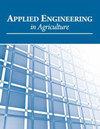在小型育肥房内连续暴露于43°C的猪胴体的反应
IF 0.9
4区 农林科学
Q4 AGRICULTURAL ENGINEERING
引用次数: 0
摘要
连续监测胴体温度和室温,以及CO、CO2、O2和NH3。从浅坑中去除胴体渗滤液时,NH3释放量约为一半。Gompertz和logistic模型很好地拟合了每日胴体质量减少和渗滤液产量的数据。摘要猪的灾难性死亡事件将对受感染尸体的管理和处理提出许多挑战。本研究探索了一种新的猪舍内生物安全处理策略,作为传统管理和处理方法的替代方案。建造了一个带有两个探索室(dr)的小型移动实验室,复制了养猪设施,以执行猪舍内处理方法的测试。尸体在43°C(110°F)的室温下加热16天,使其干燥。三具尸体(平均= 82公斤,SE=1.27公斤)被放置在DRA的各个渗滤液收集系统上,从而从房间中清除渗滤液。在DRB中的三具尸体被放置在混凝土板条上,并在下面的坑中收集累积的渗滤液。收集了室内温度、室外温度和室内温度的环境数据;以及CO2、CO、O2和NH3气体的浓度。通过直肠和肩部温度监测以及DRA中胴体和渗滤液的每日称重来表征胴体。这个不通风系统的空气交换率是基于风和热驱动的渗透来量化的。房间环境的热性能和气体水平进行了比较。对比胴体温度,数据表明地板材料对胴体内部温度没有显著影响。对渗滤液产量数据和胴体减重数据进行了Gompertz和logistic模型拟合。氨生成率在DRA组和DRB组的峰值产量分别为96.5 g AU-1 day-1 (15.8 g动物-1 day-1)和120 g AU-1 day-1 (19.7 g动物-1 day-1)。在研究中,由于去除渗滤液,DRB中NH3的生成(360 g)几乎是DRA (182 g)的两倍。进一步量化和鉴定畜舍管理策略将更好地确定发生灾难性死亡事件时的生物安全处置方法。关键词:氨,灾难性事件,处理,外来动物疾病,死亡率管理,猪。本文章由计算机程序翻译,如有差异,请以英文原文为准。
Responses of Swine Carcasses Continuously Exposed to 43°C Inside a Small-Scale Finishing Room
Highlights Carcass and room temperatures, as well as CO, CO2, O2, and NH3, were continuously monitored. NH3 release was approximately half when carcass leachate was removed from the shallow pit. Gompertz and logistic models fit data well for daily carcass mass reduction and leachate production. Abstract. A catastrophic mortality event for swine would present numerous challenges with the management and disposal of infected carcasses. This study explored a new strategy for biosecure in-barn processing of swine carcasses as an alternative to traditional management and disposal approaches. A small-scale, mobile laboratory with two discovery rooms (DRs), replicating a swine finishing facility, was constructed to execute tests of in-barn disposal methods. Carcasses were desiccated by subjection to heat at a room air temperature of 43°C (110°F) for 16 days. Three carcasses (average = 82 kg, SE=1.27 kg) were elevated over individual leachate collection systems in DRA, thereby removing leachate from the room. Three carcasses in DRB were placed on concrete slats with cumulative leachate collection in the pit below. Environmental data were collected for DR, outdoor, and slat temperatures; and CO2, CO, O2, and NH3 gas concentrations. Carcasses were characterized by rectal and shoulder temperature monitoring and daily weighing of carcasses and leachate in DRA. The air exchange rate for this unventilated system was quantified based on wind and thermal-driven infiltration. Room environments were compared for thermal performance and gas levels. Carcass temperatures were compared, and data suggested no significant impact of flooring material on internal carcass temperature. Gompertz and logistic models were fit to leachate production data and carcass mass reduction data. Ammonia generation rates were found to have a peak production rate of 96.5 g AU-1 day-1 (15.8 g animal-1 day-1) in DRA and 120 g AU-1 day-1 (19.7 g animal-1 day-1) in DRB. Over the study, the generation of NH3 in DRB (360 g) was nearly twice that of DRA (182 g) due to leachate removal. Further quantification and qualification of in-barn management strategies will better define biosecure disposal approaches in the event of a catastrophic mortality event. Keywords: Ammonia, Catastrophic event, Disposal, Foreign animal disease, Mortality management, Pig.
求助全文
通过发布文献求助,成功后即可免费获取论文全文。
去求助
来源期刊

Applied Engineering in Agriculture
农林科学-农业工程
CiteScore
1.80
自引率
11.10%
发文量
69
审稿时长
6 months
期刊介绍:
This peer-reviewed journal publishes applications of engineering and technology research that address agricultural, food, and biological systems problems. Submissions must include results of practical experiences, tests, or trials presented in a manner and style that will allow easy adaptation by others; results of reviews or studies of installations or applications with substantially new or significant information not readily available in other refereed publications; or a description of successful methods of techniques of education, outreach, or technology transfer.
 求助内容:
求助内容: 应助结果提醒方式:
应助结果提醒方式:


